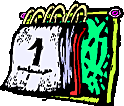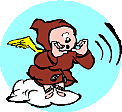With The Commentary of the RABAM


Devarim = Words, words, words. Moishe gives three speeches to the Bnei Yisroel, as impatience mounts to enter the land. The first Parsha, also called words, comprises Psookim 1:1 through 3:22.
This week we begin Sefer Devarim -- the Book of Deuteronomy, as the goyim and the Reform call it. With this, we officially begin the countdown to a day a few months from now when men will dance with other men, hand in hand, to celebrate the completion of the cycle of the reading of the Toirah. (I can't wait; I have a date with a talmid named Yerachmiel. I hope I get lucky.)
Deuteronomy = From Greek Deuteronomion (second law), because it is substantially a complete rehash. Different script-writers, though…, I mean, Moishe is no longer channeling for the…., I mean, the Sefer Dvarim is a mashal wrapped in an aggadah wrapped in a ma’amar wrapped in a…
“Men will dance with other men” = Simchas Toirah (on the same day as Shmini Atzeres in Eretz Yisroel, though the following day in the Diaspora), twelve days after Yoim Kipper, eight days after Sukkus (which lasts seven days), when the entire cycle of leyning & lerning starts again ‘at the beginning’. You will do a little happy dance.
Why will you dance?
Because you wil have finished reading Ve-zot Ha-baracha (and this is the blessing – final parsha in Devarim), and you will have circled round the Bimah making hakafois, rejoicing with the scrolls – a joyous occasion, an occasion for exultation, according to the Baal Ha Tanya (Rav Shneer Zalman). When you are happy, dance. When you are sad, dance. And when you pray, dance.
Rabbi Shneer Zalman = Rabbi Shneer Zalman Ben Baruch of Liyadi, 1745 – 1813, the Alter Rebbe (old rabbi), student of the Maggid of Mezeritch (Rabbi Dov Baer, 1704 – 1772), disciple of the Besht (Ba’al Shem Tov – Rabbi Yisroel Ben Eliezer, 1698 – 1760, the good (tov) master (ba’al) of the name (shem), founding philosopher of chassidus).
Rabbi Shneer Zalman was the founder of Chabad and the father of Rabbi Dov Baer (1773 – 1827), who moved Chabad to Lubavitch.
Chabad = Abbreviation of Chochmah, Binah, Da’as; wisdom, understanding, and knowledge. Substantially the same as the Lubavitcher movement, which originated in a town in Byelorussia. The Chabad philosophy is elucidated in Tanya, written by Rabbi Shneer Zalman, whose descendants took the name Schneerson.
The triumphant marching and dancing also recall the haftorah read at Simchas Toirah (Joshua 1:1 – 1:18), in which the Bnei Yisroel prepare to March into the land after forty years of wandering in the wastelands. Rak chazak ve ematz (be strong and resolute).
Saadia Goyn, a menuval in his own time, asks why we even bother with Sefer Devarim, which is largely a restatement of the preceding books of the Toirah. Why not jump straight into Beraishis?
Saadia Gaon = Rabbeinu Saadiya Ben Yosef (892 - 942), a philosopher, grammarian, linguist, and rosh yeshiva (known in Arabic as Said Ibn Yusuf El-Fayyumi) from Fayyum in upper Egypt, who settled in Baghdad. The book he is probably best know for is the Kitab Al-Amanat Wa’l Itikadat (The Book of Doctrines & Beliefs - in Hebrew: Sefer Ha Emunot Ve Ha Deot). He wrote in Arabic, reflecting the lomdishe oilam in which he lived – Baghdad was the intellectual center of the Mediterranean world at that time.
Beraishis = At the beginning. When Reb Nachman of Bruxelles was asked why we start at the beginning, he responded “don’t ask, just dance, bitch”. Farbrengen with Reb Nachman often left his talmidim exhausted.
According to the RAN, the repetitive nature of Devarim is directly related to its being read in the summer months, during which we customarily are relegated to repeat episodes of all of our favorite shows. Indeed, the RAMBAM, in his famous introduction to Hilchois Depreciation, suggests that to keep the Toirah fresh, we should pre-empt the entire Sefer Devarim and replace it with an original dramatic anthology series on famous Jewish tax evaders. We don't hold like the RAMBAM, however, because even if we had new episodes every five minutes, we wouldn't have enough time over the summer to do justice to the topic.
RAN = Rabbeinu Nisim ben Rav Reuven Girondi (d. ~1380), whose supercommentary on the mefarsh of the RIF (Rabbi Isaac ElFassi, 1013-1103) is usually printed in the back of the Gemara together with the RIF’s Seyfer Halachois.
RAMBAM = The one scholar you will never escape, the ‘Dear Moishe’ of his time. Author of the Yad HaChazakah, which is a famous book on discipline. No family should be without this work. Rabbi Moishe Ben Maimon (1135 – 1204).
Many of the Tsarfatim (French Rabbis of the twelfth and thirteenth centuries) and the Chassidei Ashkenaz (German pietist rabbis of the same period) were outraged, outraged, at Rabbi Moishe’s approach to Halacha – the quarrel has not been laid to rest yet, but slumbers still. Until some kakferkopf inadvertently quotes the wrong thing in the wrong place.
The Maimonidean controversy flares up most strangely when misnagdim and chassidim quote the Rambam at each other in order to prove how wrong the other is.
Damn hippies.
Hilchois = Laws. The deep and wondrous realm that is Halacha. And stuff.
The RASHBA agreed completely. In his shtetl one year he preempted the entire Sefer Devarim with a new reality series entitled "Who Wants To Marry a Sheitelmacher." The series was cancelled after one season, however, as there was little interest in marrying a woman with the hair of a hot shiksa and the body of Moby Dick.
RASHBA = Rabbeinu Shlomo Ben Avraham Aderet (d. 1310). He was a student of Rabbeinu Yonah (Yonah of Gerondi, Author of Shaarei Teshuva – the gates of repentance), but also studied under the Ramban (Rabbi Moishe Ben Nachman, 1194 – 1270). He authored several thousand responsa, which are still referenced.
New reality series = After the disastrous failure of ‘Two Spies and a Harlot’, based on the second chapter of Joshua, the critics were in no mood to cut him any slack, labeling the show ‘puerile, jejune, and fatuous’.
Truth be told, casting could have been better – Rob Schneider as the suitor was bad enough, but Roseanne Bar as Golda Meir was utterly unbelievable. Not even Joan Rivers’ frequent guest appearances as LaShonne Hara could save this stinker.
“A woman with the hair of a hot shiksa and the body of Moby Dick” = I mentioned my mechutenista, yes?
Hot Shiksa = Do not discuss this subject with your mother. Both a brocho and a klala – a blessing and a curse. Your therapist will be fascinated.
So we do read Sefer Devarim. In it, we are witness to Moishe Rabbeinu standing before Klal Yisroel in the desert as he is about to exit the stage of history, summarizing Klal Yisroel's achievements, reviewing rules and regulations, and basically reminding the Bnei Yisroel that they are a bunch of rebellious good for nothing minuvals.
About to exit the stage of history = 120 years old, having been president of the board for forty years. Geezer.
Why do so many in the Torah live to great age? One authority holds that this is a narrative convention used to highlight their stature and greatness. But another points out that it is assuredly a great victory to outlive one’s mechutenim (in laws), baruch hashem.
Reminding the Bnei Yisroel = Moishe mentions every single place in the last forty years where they went astray, from Horeb (Mt. Sinai) to Bashan, and points out that it is their fault that he cannot enter the Eretz HaKoidesh. They were wrong, he told them so many times, but did they listen? Noooo! This pattern should be familiar, as it is the arch-type of the guilt-trip. Three long rants and a hoohah – just so you don’t forget. Nudnik Rabbeinu.
A Gemarra in Pesachim asks why Moishe didn't simply distribute a pamphlet in order to save time and the expense of organizing a large gathering of all of Klal Yisroel.
According to Rav Yehuda, Moishe simply liked the power of the stage, and relished the opportunity to lead one last political rally.
Didn’t simply distribute a pamphlet = Because he was reminding the people of that which had been promised to them, and also thus holding the Aimishteh to the terms of the deal, as it says in Shmos 32:13 "Zechor le Avraham, le Yitzhak u le Yisrael, avadeicha, asher nishbata lahem bach va tedaber aleihem arbe et zarachem ke chochvei ha shamayim, ve chol ha'aretz hazot asher amarti eten le zarachem ve nachalu le olam." (Remember Avraham, Yitzchak, and Yisrael, Your servants, to whom You swore your self and said to them, 'I will multiply your descendants like the stars of heaven, and all this land of which I have spoken, I give to your seed, and they shall inherit it forever.)
Rav Yehuda = Rabbi Yehudah HaNasi (135 CE – 219 CE), who redacted the Mishna (the primary part of the Talmud). He was the son of Rav Shimon Ben Gamaliel. He is featured in the Ethics of the Fathers (Pirkei Avos), and you should remember this quote “I learned much from my teachers, more from my associates, but most of all from my students.”
Pesachim = A tractate of the Talmud in the order Mo’ed (festivals).
But according to Rav Ashi, Moishe really milked this thing into a big money maker: He charged for attendance, got a piece of the food concessions (five dollars for a kosher hot dog in the desert), and sold licensed products such as Moishe Rabbeinu golf shirts, stuffed Toirahs for the kids, and big orange sponge hands saying "We're Number One". He also set up a website and internal satellite network and charged for pay-per-view access.
Rav Ashi = Head of the Academy at Sura, and one of the main editors and compilers of the Babylonian Talmud (his colleague Ravina is also thus credited). Date of birth is not certain, niftar in 427 CE.
Kosher hot dog = Hebrew National, about whom Chazal says “they answer to a higher authority”. A popular brand -– who doesn’t like Hebrews? (Although considered traifus gammur by the Orthodox Rabbinate due to the company's unwillingness to shell out for the leading Orthodox certification.)
This week, in the first Parsha of Devarim, we focus on the sojourning, the travels, and the battles of the previous forty years.
According to Rabbeinu Tam, of all his achievements, Moishe Rabbeinu was most proud of his beating Oig Melech Habashan, which is why there is so much detail of their encounters in this week's Parsha.
Oig Melech Ha Bashan = Og the king of Bashan; a giant baddy (last of the Refeyim, who were giants) mentioned in Parshas Chukass, perek 21, psook 33. His name means ‘cake’. Oy vey. “Va yetsei Og Melech Ha Bashan likratamhu ve chol amo la milchama Edrei (and Og the king of Bashan went out to oppose him with all his people, to wage war at Edrei). The Bnei Yisroel whack him, and all his sons, and all his people, exterminating them utterly, and then seize his land – “Va yaku oto ve et banav ve et kol amo, ad bilti hishir lo sarid, va yirtsu et artzo”. Psook 35. Lo sarid = No survivors.
According to a famous medrish, Moishe was twenty amois high, he held a stick twenty amois high, and he jumped twenty amois high, and he only reached Oig's ankle. Yet he was able to knock Oig down to the ground, and then proceeded to cut off Oig's private parts, which he used as a tent on family camping trips.
Medrish = A Tale which explains and illuminates a theme in Torah or Talmud.
Amois = An arm’s length, a cubit. From a word meaning arm. Plural amos, singular amah.
But a different medrish tells us that Moishe and Oig really settled their disputes through arm wrestling. After much struggle, Moishe won the match, and in turn received all of the land east of the Jordan River on behalf of Klal Yisroel. While Oig, upon losing his kingdom, was forced to work as a telemarketer and sell Amway products in his spare time.
Arm wrestling = Because, according to Rashi, Moishe was still strong and healthy even at that age. Oig, on the other hand, had lived several centuries longer, having even been alive during the makbool (the flood).
The MAHARAL has a beautiful interpretation of this event. He suggests that Moishe Rabbeinu never actually fought Oig. Indeed, he never met him, though did read an article about him once. Rather, Moishe created this legend to build excitement about the prospects of entering the Eretz Yisroel, to unify the people, and to make people forget about the whole "Babylon has weapons of mass destruction" debacle.
The Maharal = Moreinu Ha Rav Loew – our teacher the rabbi Loew. Rabbi Yehudah Ben Betzalel Loew of Prague (1525 – 1609), whose family came from Worms (Germany) in the preceding generation. Son of Betzalel Ben Chayim, younger brother of Chayim Ben Betzalel, older brother to Sinai and Shimshon. He was a descendant of Dovid Ha Melech and Rashi; the Rebbe of Prolicz said about him: “Er hott yichus vi es komt oys di oiren, nebech” (Ma’amar Reishis Sh’tuyos).
The Maharal was famous as a Talmudist and writer, author of the books Tiferet Yisroel (about Torah teachers), Be’er Ha Golah (a defense and discursus on Talmud), Or Chadash (regarding Ester Ha Malka), Netivot Shalom (on ethics), Gur Aryeh (a commentary on Rashi), Gvurat Ha Shem (commentary on the Peysach Haggadah), amongst other works. Onetime chief rabbi of Prague and Posen, and landsrabbiner of Moravia. A mensh. And incidentally, the central figure in the legend of the golem of Prague, that being a creature he brought to life to whack local anti-Semites.
Babylon has weapons of mass destruction = At the time when Melech Ha Sneh meddled in the affairs of Babylon, it was fortuitously ‘discovered’ that the Babylonians had re-armed, and were preparing for war. But after the war was fought, none of the allegations were substantiated, wherefore mi lifnei heychal (before the palace) the mother of Kasei lamented: “wherefore did my son die?” And to this day, Melech Ha Sneh has no answer.
Indeed, just as the Jews stood on that mountain overlooking the Promised Land, we too, in our generation, stand at a critical juncture in our history. Do we push forward, or step backward? Do we move into the future, or recede into the past? Our wives are relying on us to make the right decisions, as are our children, grandchildren, and great grandchildren.
That Mountain = On the other side of Jordan: because Moishe was not zoiche to enter the land. In the last part of the previous book (Sefer Bamidbar), it says ‘in the plains of Moab’. But the Bnei Yisroel overlook the land, hence an escarpment or plateau, which is like a plain, can be postulated.
At the end of Dvarim Moishe ascends Mount Nebo, to the top of Pisgah, and looks out over the land as far as Tzoar. “Va ya’al Moishe me arvot Moav, el har Nabo, rosh ha Pisgah….” (Psook 34:1).
So you owe it to them: Stop having children, for Reboinoisheloilum's sake! Get that vasectomy already! The last thing you need to do is to start with those midnight feedings again. And more yeshiva tuition? No -- save some money for the strip clubs and traifus. You're not getting any younger, you know. Moishe knew that the only choice was to move into the future. We should all embrace his wisdom.
Midnight feeding = Avoidah chatzois – a mitzvah with a time component, which women are also obligated to perform.
Yeshiva tuition = A cause for eicha. As is described so eloquently in Parshas Re’eh: “Re’eh, anochi noten lifnei-chem hayom bracha u klala.” This will be elaborated upon three parshayos hence.
Ah Gutten Shabbos, you self-hating Jew.



